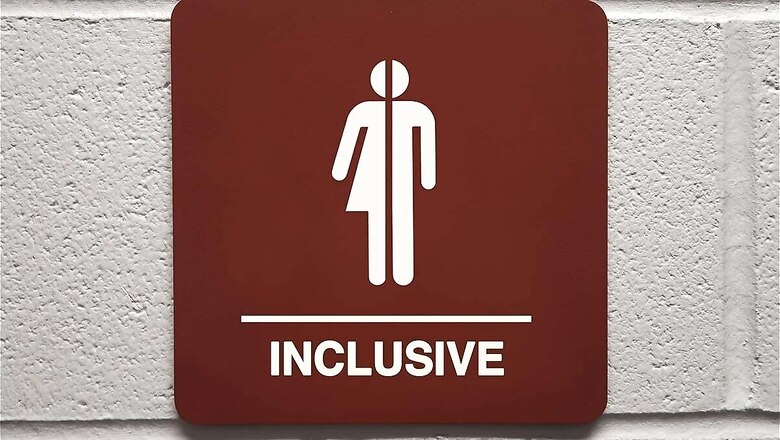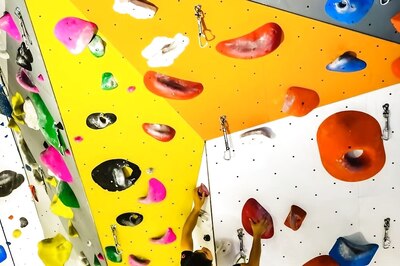
views
In a well-known and oft-repeated anecdote, Sudha Murthy recounts being the first girl student in her Engineering college. There were 600 students there, and she was the only girl amongst them. It was so unusual for women to aspire to engineering back then, that her college didn’t even have a girl’s toilet. That was in the 1960s.
Since then, we’ve focused on uplifting the girl child, on educating her, on making her a part of the workforce, and on making her financially independent. But, as Mark Balla’s book, Toilet Warrior will tell you, if you don’t give her a safe and clean toilet, she will drop out.
Imagine if your workplace told you that they took gender equality seriously, and that they were working hard to fix glass ceilings for women and pay gap issues… and they had no toilets for women. Would you take them seriously? No. It would look like lip service – all talk, without the walk.
And yet, we let these same workplaces off the hook on diversity, when they have no toilets for people who are transgender, intersex or non-binary. We believe that these corporations, colleges, shopping malls, movie theatres, restaurants, etc are allies when they display pride colours, but fail to notice that should transgender, non-binary and intersex people come to work/play/learn in these spaces, they’d have nowhere to go to the toilet.
Isn’t that just lip service towards the LGBTQ+ community at a societal level? And a very big collective blind spot?
Fortunately, the solution isn’t one that needs a serious infrastructure overhaul. Often, all we need are a few updates to existing facilities to convert them into gender neutral toilets. These facilities are designed without gendered signage and eliminate the need for individuals to conform to a specific gender identity. Inclusive toilets may offer additional amenities such as accessibility features, baby changing facilities, dispensers for sanitary products, and other specific requirements depending on the context. They are alternatively referred to as all-gender, gender-neutral, or unisex toilets, emphasising their commitment to inclusivity and dismantling the barriers created by traditional gender divisions.
Why are inclusive toilets important for gender equality?
Inclusive toilets are important for gender equality for several reasons:
- We know now that gender is a spectrum. The traditional gender segregated toilet recognises and validates only male and female genders, thereby ‘othering’ everyone else.
- Inclusive toilets respect the diversity of gender identities and expressions, and discriminate against no one. An inclusive toilet is for everyone. They promote equality and dignity for all people, regardless of their gender identity or expression, by providing them with safe and adequate toilets.
- They reduce the risk of discrimination, harassment, and violence that transgender, intersex and nonbinary people often face when using gender-segregated toilets.
- They foster inclusive societies that value diversity and respect human rights, by creating spaces that welcome and accommodate everyone.
How do inclusive toilets contribute to social progress?
Inclusive toilets contribute to social progress by creating positive impacts on various aspects of society, such as:
Education
The findings of a 2021 survey conducted across India by the Indian Institute of Management Ahmedabad, Boston Consulting Group, and Pride Circle serve as a poignant reminder of the challenges the LGBTQ+ community endures. Shockingly, 64% of LGBTQ+ students have experienced discrimination or ridicule, with 92% enduring mocking, 59% enduring bullying, and 26% facing social exclusion. Perhaps most troubling is the fact that 36% of these students choose to keep their true selves hidden, afraid to reveal their identities due to the lack of LGBTQ+ friendliness on campus.
Just like the provision of clean and safe toilets improves attendance for girl students, the same is true for transgender and nonbinary students, who may otherwise avoid going to school or using the toilet due to fear of bullying or violence. Inclusive toilets can also create a more supportive and respectful learning environment for all students, by fostering awareness and acceptance of gender diversity.
Health
Many transgender and/or non-binary people prefer to ‘hold it’, rather than subject themselves to the indignity of going to a toilet where they aren’t welcome. Physically, this can lead to the development of urinary tract infections, kidney problems, and other related health issues. Moreover, many of them also resort to restricting their food and water intake. This can, and does, lead to dehydration, especially in our weather. According to a study, among the transgender and/or nonbinary youth who experienced bathroom discrimination, 85% reported depressive mood and 60% seriously considered suicide. These experiences are echoed by transgender and non-binary people everywhere, including India. Inclusive toilets lead to better physical and mental health for all users.
Economy
According to the World Bank, poor toilet sanitation costs the global economy $260 billion per year in lost productivity. To put this in context for the LGBTQ+ community, according to the 2011 Census, there are 4.88 lakh transgender individuals in India, of which 55,000 are children. Each of these people has much to contribute to our nation, to their families and to themselves. But they can’t do so when we create barriers to them meeting their most basic needs. When the LGBTQ+ community has access to gender-inclusive toilets, it enables them to participate more actively in the workforce.
What are some examples of inclusive toilets around the world?
Inclusive toilets are becoming more common around the world, as more governments, organisations, businesses, and individuals recognise their benefits and adopt them in various settings. Some examples of inclusive toilets are:
In England and Wales, transgender people have been legally entitled to use gender-segregated toilets that align with their gender identity since the introduction of the Equality Act (2010). However, many public venues have also implemented gender-neutral toilets to provide more options and accessibility for their customers and staff. For instance, some universities, museums, libraries, theatres and pubs have converted some or all of their existing toilets into unisex facilities.
In Canada, several provinces and municipalities have passed laws or policies that require public buildings to provide at least one gender-neutral toilet. For example, Vancouver passed a bylaw in 2018 that mandates all new and renovated city-owned buildings to have at least one universal washroom. Similarly, Ontario passed a law in 2015 that requires all newly built or extensively renovated public buildings to have at least one barrier-free washroom.
In China, the first unisex and gender-neutral toilets were constructed sometime before 2013. Since then many districts have accepted the concept. Some cities have experimented with gender-neutral toilets as a way to address the issue of long queues for women’s toilets. For example, Beijing launched a pilot project in 2016 that converted some public toilets into unisex facilities with individual stalls. The project received positive feedback from users who appreciated the convenience and privacy of the new design.
In Nepal, Bageshwori Park was the first public space to have two unisex toilets. The MP used the Parliamentarian Development Fund to establish bathrooms for a growing trend in Nepal to offer accommodations for transgender people. Several organisations and alliances within Nepal continue to support separate toilets for transgender students within the public and private school systems.
How is India adopting inclusive toilets?
In India, while inclusive toilets may not be widespread, there are inspiring examples of educational institutions taking proactive steps. One notable case is the Indian Institute of Technology (IIT) Bombay, where gender-neutral toilets were installed on campus as early as 2017. This initiative was championed by Saathi, an LGBTQ+ student support group at IIT Bombay, showcasing the power of student-led advocacy in fostering inclusivity.
Another institution leading the way is the Tata Institute of Social Sciences (TISS) Mumbai, which also introduced gender-neutral toilets on its campus in 2017. The effort was spearheaded by Queer Collective, an LGBTQ+ student group at TISS Mumbai, emphasising the importance of student-driven initiatives in creating safe and inclusive spaces for all.
Today, several Indian universities are recognising the need for gender-neutral toilets. Institutions such as IIT Delhi have taken the initiative to inaugurate gender-neutral washrooms on their campuses. In fact, IIT Delhi now boasts 14 such facilities. Additionally, Tezpur University in Assam and the National Academy of Legal Studies and Research (NALSAR) in Andhra Pradesh have also embraced gender-neutral washrooms, recognising the importance of providing an inclusive environment for all students. NALSAR goes a step further by adopting a gender-neutral trans policy and the recognition of a gender-neutral title, “Mx,” on student’s certificates, paving the way for other institutions to follow.
More recently, the Supreme Court set another precedent by establishing nine gender-neutral bathrooms within the august corridors of the Court itself.
Both the government and corporate India have taken up the mantle of change, including the leading brand in the lavatory care segment, Harpic. With a genuine understanding and an open-hearted approach, Harpic has made significant strides in ensuring its products cater to the diverse fabric of society, including the LGBTQ+ community. Recognising the transformative power of education in shaping attitudes, Harpic has launched inspiring campaigns that shed light on the various gender identities that exist. These impactful initiatives serve to awaken and nurture society, fostering an environment of acceptance.
One noteworthy collaboration between Harpic and News18, known as ‘Mission Swachhta aur Paani,’ goes beyond the concept of cleanliness alone. It is a movement that acknowledges the profound importance of toilets, viewing them not just as functional spaces, but as symbols of safety and inclusivity for marginalised individuals. This exceptional mission is founded on the belief that clean and inclusive toilets are essential for building a society that unconditionally embraces and empowers everyone. With unwavering dedication, Harpic and News18 actively include and advocate for the LGBTQ+ community, spreading the message that every individual deserves access to safe and accepting spaces where their dignity is respected, and their presence is warmly embraced.
Conclusion
Inclusive toilets are more than just facilities for bodily functions. They are equalisers of opportunity. When an office has a gender neutral toilet, it becomes a workplace that welcomes everyone. Ditto colleges, museums, public parks, and everywhere else.
Gender neutral toilets are symbols of social change and progress, reflecting and shaping the values and norms of our societies. By providing safe and adequate toilets for everyone, regardless of their gender identity or expression, inclusive toilets can contribute to advancing gender equality and fostering inclusive societies. Inclusive toilets are not only a matter of convenience, but also a matter of human rights and dignity.
Join us here, to learn how you can do your part in this national conversation.




















Comments
0 comment